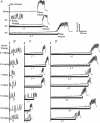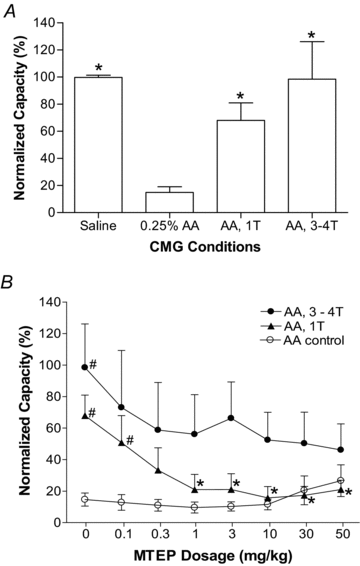Involvement of metabotropic glutamate receptor 5 in pudendal inhibition of nociceptive bladder activity in cats
- PMID: 22005674
- PMCID: PMC3249053
- DOI: 10.1113/jphysiol.2011.215657
Involvement of metabotropic glutamate receptor 5 in pudendal inhibition of nociceptive bladder activity in cats
Abstract
This study used MTEP, a metabotropic glutamate receptor 5 (mGluR5) antagonist, to examine the role of mGluR5 in the neural control of the urinary bladder and in the inhibition of the micturition reflex by pudendal nerve stimulation (PNS). Experiments were conducted in 11 female cats under α-chloralose anaesthesia when the bladder was infused with either saline or 0.25% acetic acid (AA). AA irritated the bladder, induced bladder overactivity and significantly (P < 0.001) reduced bladder capacity to 14.9 ± 10.3% of the saline control capacity. MTEP (0.1-50 mg kg(-1), i.v.) significantly (P < 0.05) increased bladder capacity during saline distension but not during AA irritation. However, MTEP induced a transient inhibition of isovolumetric bladder contractions under both conditions. PNS (5 Hz), which was tested at the threshold (T) intensity for inducing a complete inhibition of isovolumetric bladder contractions and at an intensity of 3-4T, suppressed AA-induced bladder overactivity and significantly increased bladder capacity to 68.0 ± 31.3% at 1T (P < 0.05) and 98.5 ± 55.3% at 3-4T (P < 0.01) of the saline control capacity. MTEP dose dependently (0.1-50 mg kg(-1), i.v.) suppressed PNS inhibition of bladder overactivity at low intensity (1T) but not at high intensity (3-4T). During saline infusion PNS significantly (P < 0.05) increased bladder capacity to 167.7 ± 27.1% at 1T and 196.0 ± 37.4% at 3-4T. These inhibitory effects were not observed after MTEP (0.1-50 mg kg(-1), i.v.) which also increased bladder capacity. These results indicate that glutamic acid has a transmitter function in bladder and somato-bladder reflex mechanisms and raise the possibility that mGluR5 may be a target for pharmacological treatment of lower urinary tract disorders.
Figures







Similar articles
-
Role of spinal metabotropic glutamate receptor 5 in pudendal inhibition of the nociceptive bladder reflex in cats.Am J Physiol Renal Physiol. 2015 Apr 15;308(8):F832-8. doi: 10.1152/ajprenal.00623.2014. Epub 2015 Feb 11. Am J Physiol Renal Physiol. 2015. PMID: 25673810 Free PMC article.
-
Sympathetic β-adrenergic mechanism in pudendal inhibition of nociceptive and non-nociceptive reflex bladder activity.Am J Physiol Renal Physiol. 2016 Jul 1;311(1):F78-84. doi: 10.1152/ajprenal.00180.2016. Epub 2016 May 11. Am J Physiol Renal Physiol. 2016. PMID: 27170683 Free PMC article.
-
Effect of methysergide on pudendal inhibition of micturition reflex in cats.Exp Neurol. 2013 Sep;247:250-8. doi: 10.1016/j.expneurol.2013.05.006. Epub 2013 May 18. Exp Neurol. 2013. PMID: 23688680 Free PMC article.
-
Metabotropic glutamate receptor subtype 5 antagonists MPEP and MTEP.CNS Drug Rev. 2006 Summer;12(2):149-66. doi: 10.1111/j.1527-3458.2006.00149.x. CNS Drug Rev. 2006. PMID: 16958988 Free PMC article. Review.
-
Pharmacologic perspective on the physiology of the lower urinary tract.Urology. 2002 Nov;60(5 Suppl 1):13-20; discussion 20-1. doi: 10.1016/s0090-4295(02)01786-7. Urology. 2002. PMID: 12493344 Review.
Cited by
-
Efficacy of different spinal nerve roots for neuromodulation of micturition reflex in rats.Oncotarget. 2018 Jan 4;9(17):13382-13389. doi: 10.18632/oncotarget.23950. eCollection 2018 Mar 2. Oncotarget. 2018. PMID: 29568364 Free PMC article.
-
Propranolol, but not naloxone, enhances spinal reflex bladder activity and reduces pudendal inhibition in cats.Am J Physiol Regul Integr Comp Physiol. 2015 Jan 1;308(1):R42-9. doi: 10.1152/ajpregu.00368.2014. Epub 2014 Nov 12. Am J Physiol Regul Integr Comp Physiol. 2015. PMID: 25394827 Free PMC article.
-
Superficial peroneal neuromodulation of persistent bladder underactivity induced by prolonged pudendal afferent nerve stimulation in cats.Am J Physiol Regul Integr Comp Physiol. 2021 May 1;320(5):R675-R682. doi: 10.1152/ajpregu.00346.2020. Epub 2021 Mar 10. Am J Physiol Regul Integr Comp Physiol. 2021. PMID: 33719564 Free PMC article.
-
Somatic modulation of spinal reflex bladder activity mediated by nociceptive bladder afferent nerve fibers in cats.Am J Physiol Renal Physiol. 2014 Sep 15;307(6):F673-9. doi: 10.1152/ajprenal.00308.2014. Epub 2014 Jul 23. Am J Physiol Renal Physiol. 2014. PMID: 25056352 Free PMC article.
-
Additive Inhibition of Reflex Bladder Activity Induced by Bilateral Pudendal Neuromodulation in Cats.Front Neurosci. 2020 Feb 7;14:80. doi: 10.3389/fnins.2020.00080. eCollection 2020. Front Neurosci. 2020. PMID: 32116523 Free PMC article.
References
-
- Alvarez FJ, Villalba RM, Carr PA, Grandes P, Somohano PM. Differential distribution of metabotropic glutamate receptors 1a, 1b, and 5 in the rat spinal cord. J Comp Neurol. 2000;422:464–487. - PubMed
-
- Andersson KE, Wein AJ. Pharmacology of the lower urinary tract: Basis for current and future treatments of urinary incontinence. Pharmacol Rev. 2004;56:581–631. - PubMed
-
- Anwyl R. Metabotropic glutamate receptors: electrophysiological properties and role in plasticity. Brain Res Rev. 1999;29:83–120. - PubMed
-
- Bhave G, Karim F, Carlton SM, Gereau RW. Peripheral group I metabotropic glutamate receptors modulate nociception in mice. Nat Neurosci. 2001;4:417–423. - PubMed
-
- Booth AM, Hisamitsu T, Kawatani M, de Groat WC. Regulation of urinary bladder capacity by endogenous opioid peptides. J Urol. 1985;133:339–342. - PubMed
Publication types
MeSH terms
Substances
Grants and funding
LinkOut - more resources
Full Text Sources
Other Literature Sources
Medical
Miscellaneous

